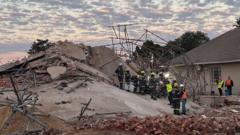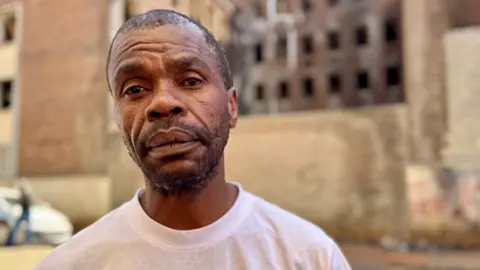South Africa's Public Works Minister Dean Macpherson announced that a devastating building collapse in George, which resulted in the deaths of 34 construction workers last May, was "entirely preventable." The government has released a damning report indicating that red flags regarding safety practices had been ignored, leading to the tragedy.
Macpherson described multiple factors contributing to the disaster, including the utilization of inferior materials, the presence of structural cracks, and visible gaps in the building that were flagged prior to the incident. He expressed frustration during a press briefing, asserting that these issues were known for a year before the collapse yet work continued without pause.
"Red flags that were continually raised about this project were dismissed," Macpherson said. According to the report, a health and safety officer resigned in protest due to these concerns, yet construction proceeded with evident safety risks. Workers on site had even reported feelings of vibrations coming from the partially built structure, only to be instructed to use sand to cover holes as a temporary patch.
In a meeting with survivors and the families of victims, Macpherson described the encounter as "emotional and painful," stressing the need for criminal accountability for those who may have acted negligently. While a police investigation remains active, as of now, no arrests have been made.
Survivors are grappling with psychological trauma and mounting medical expenses, highlighting ongoing struggles for those affected. One survivor, Elelwani, shared her story of physical and emotional hardship—from medical issues to the burden of social ridicule—pleading for assistance from the community.
In response to this tragedy, Macpherson pledged to implement stricter regulations aimed at enhancing oversight in construction practices and addressing outdated legislation. This inquiry, carried out by the Council for the Built Environment alongside the Engineering Council of South Africa, underscores a call for rigorous reforms within the industry to avert future tragedies.
Macpherson described multiple factors contributing to the disaster, including the utilization of inferior materials, the presence of structural cracks, and visible gaps in the building that were flagged prior to the incident. He expressed frustration during a press briefing, asserting that these issues were known for a year before the collapse yet work continued without pause.
"Red flags that were continually raised about this project were dismissed," Macpherson said. According to the report, a health and safety officer resigned in protest due to these concerns, yet construction proceeded with evident safety risks. Workers on site had even reported feelings of vibrations coming from the partially built structure, only to be instructed to use sand to cover holes as a temporary patch.
In a meeting with survivors and the families of victims, Macpherson described the encounter as "emotional and painful," stressing the need for criminal accountability for those who may have acted negligently. While a police investigation remains active, as of now, no arrests have been made.
Survivors are grappling with psychological trauma and mounting medical expenses, highlighting ongoing struggles for those affected. One survivor, Elelwani, shared her story of physical and emotional hardship—from medical issues to the burden of social ridicule—pleading for assistance from the community.
In response to this tragedy, Macpherson pledged to implement stricter regulations aimed at enhancing oversight in construction practices and addressing outdated legislation. This inquiry, carried out by the Council for the Built Environment alongside the Engineering Council of South Africa, underscores a call for rigorous reforms within the industry to avert future tragedies.



















